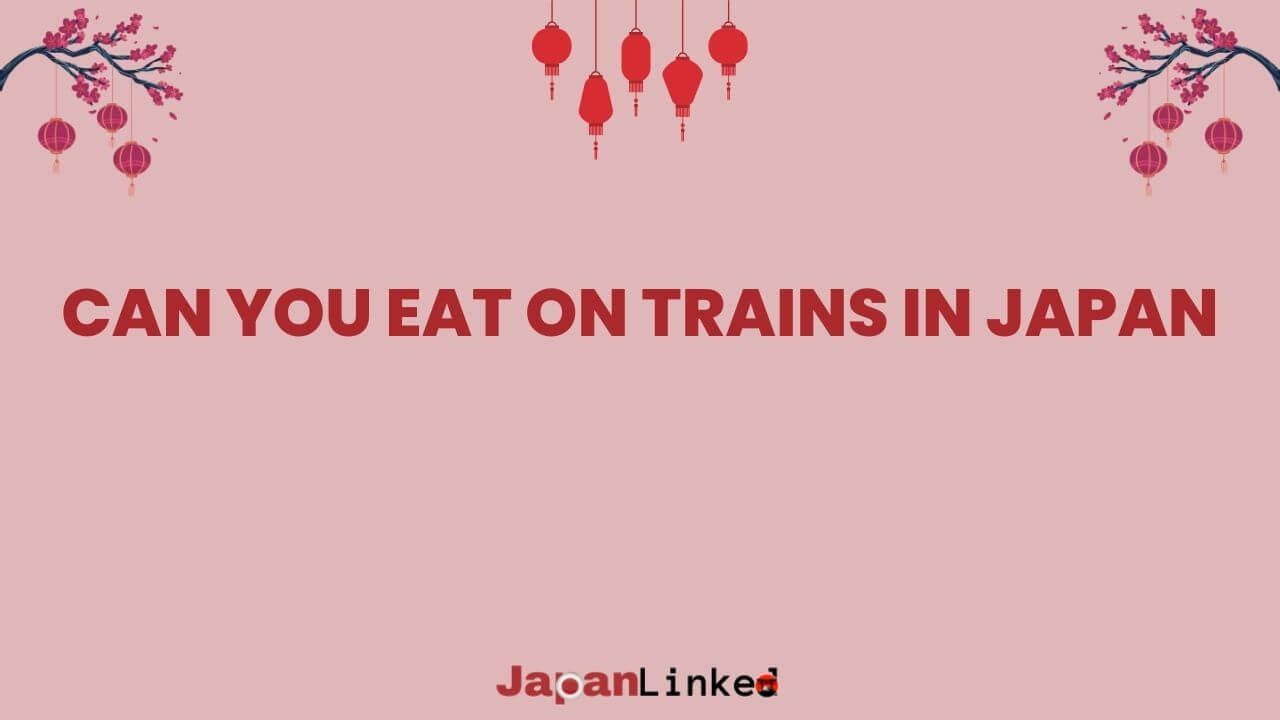Japan’s train network is a marvel of efficiency, punctuality, and cleanliness that leaves many first-time visitors in awe.
From the lightning-fast Shinkansen (bullet trains) to the intricate web of local lines connecting even the most remote villages, trains are the backbone of Japanese transportation.
But beyond their technical excellence, Japanese trains also offer a window into the country’s cultural values—particularly the delicate balance between personal convenience and collective harmony.
For travelers, one common question arises: “Can you eat on trains in Japan?” The answer isn’t a simple yes or no. Instead, it reflects Japan’s nuanced approach to public behavior, where context matters tremendously.
In Japan, train etiquette is taken seriously, and understanding the unwritten rules about eating is essential for respectful travel.
The general principle follows a thoughtful logic: eating is typically acceptable on long-distance journeys where passengers need sustenance, but discouraged on shorter commuter routes where it might inconvenience others in close quarters.
This distinction stems from the Japanese concept of meiwaku (迷惑)—causing trouble or inconvenience to others—which is carefully avoided in public spaces.
When trains are packed with commuters, the sounds of unwrapping food, potential spills, and lingering aromas could disrupt the peaceful environment that Japanese society values.
In this comprehensive guide, we’ll explore:
- The specific rules for different train types, from Shinkansen to local lines
- The fascinating tradition of ekiben (station bento boxes) and how to enjoy them
- Practical tips for navigating meal times during your Japanese train adventures
- Cultural insights to help you blend in with local customs
Whether you’re planning a bullet train journey across the country or navigating Tokyo’s busy metro system, understanding when and how to eat on Japanese trains will enhance your travel experience while showing respect for local customs.
Eating on Long-Distance Trains: When and How It’s Acceptable
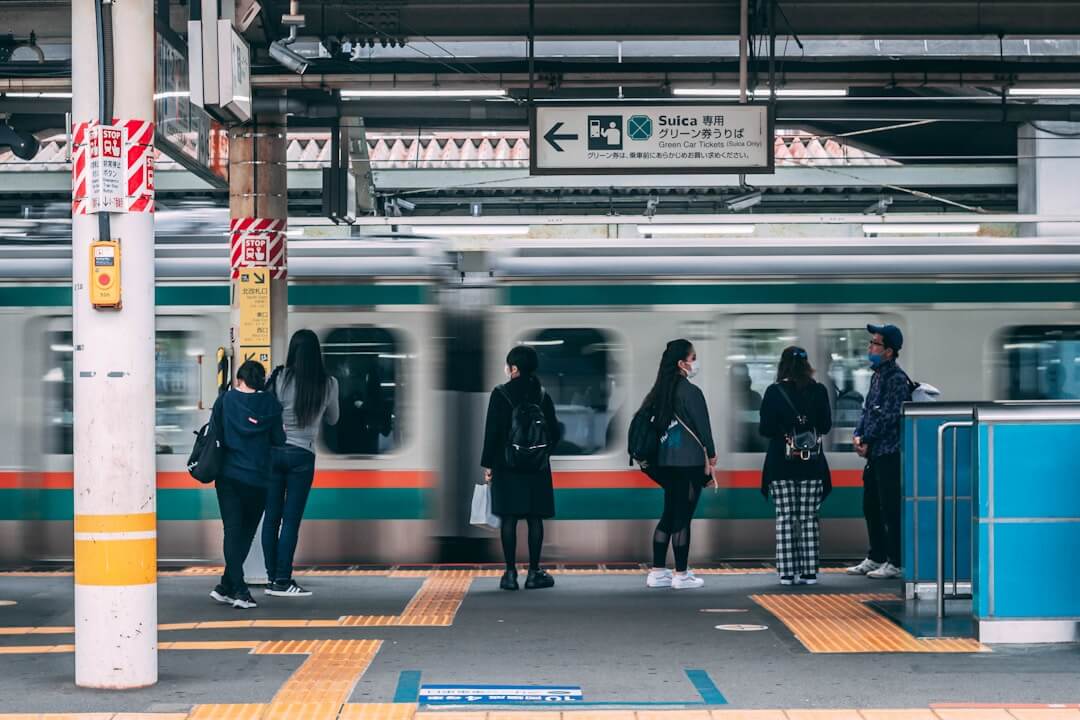
Japan’s long-distance trains offer a unique opportunity to enjoy a meal while watching the scenery pass by. Unlike local commuter trains, these journeys are designed for comfort during extended travel times, making them perfectly suitable for dining.
Types of Trains Where Eating is Acceptable
Shinkansen (Bullet Trains) are perhaps the most famous trains where eating is not only permitted but is practically part of the experience. These high-speed marvels connecting major cities across Japan feature spacious seating, tray tables, and even food vendors passing through carriages on some routes.
Limited Express Trains (tokkyū) that connect regions over medium to long distances also accommodate dining. While slightly slower than the Shinkansen, these trains provide a comfortable environment for enjoying a meal during your journey.
Overnight Sleeper Trains, though increasingly rare in modern Japan, traditionally allow passengers to eat in their compartments or designated dining areas.
Tourist Trains and Joyful Trains (themed sightseeing trains) often incorporate dining as part of the experience, with some even featuring special restaurant cars or gourmet meal services.
Facilities Available for Eating
Most long-distance trains come equipped with practical amenities that make dining comfortable:
- Fold-down tray tables attached to the seat in front of you (or in the armrest for front-row seats)
- Cup holders designed to prevent spills during the journey
- Garbage bags or bins located near doors or at the end of carriages
- Spacious seating with enough room to comfortably enjoy a meal
Some newer Shinkansen models even feature electrical outlets at seats, allowing you to heat beverages or use small appliances if needed.
Green Car and Reserved Seating Etiquette
The Green Car (first-class) experience comes with additional expectations regarding dining etiquette:
- While eating is certainly permitted, passengers are expected to be especially mindful of noise and mess
- The premium environment calls for more refined behavior—think “restaurant manners” rather than casual dining
- Many Green Car passengers opt for more elegant ekiben or bring higher-end food items that match the upscale atmosphere
In reserved seating across all train classes, the standard etiquette applies:
- Use your tray table rather than balancing food on your lap
- Be conscious of your neighbors’ space and comfort
- Avoid foods with excessive crumbs that might spill onto neighboring seats
How Japanese Passengers Typically Behave
Observing how Japanese travelers approach eating on trains can provide valuable insight:
- Most Japanese passengers prepare thoroughly, bringing appropriate utensils, napkins, and sometimes even small portable waste bags
- There’s a noticeable emphasis on minimal noise—you’ll rarely hear loud unwrapping or crunching sounds
- Japanese travelers typically wait for a smooth section of track before attempting to drink hot beverages
- After eating, passengers meticulously clean their seating area, leaving no trace of their meal
- Many will wait until designated stops to dispose of garbage if no bin is readily available in their car
On particularly crowded trains, even when eating is permitted, some Japanese passengers may choose to wait until the train is less busy before enjoying their meal—a considerate gesture worth emulating.
The culture of eating on long-distance trains in Japan balances practicality with consideration for others, making it a pleasant experience for everyone when the unwritten rules are followed.
Also Read: Can You Eat Outside In Japan? & Can You Walk And Eat In Japan?
The Art of Ekiben: Japan’s Beloved Train Bento Boxes

Japan’s train journeys offer more than just efficient transportation—they provide a unique culinary experience through ekiben (駅弁), the special bento boxes designed specifically for train travel.
These railway meals are not merely convenient food options but represent a delicious intersection of Japanese culinary tradition, regional pride, and the romance of rail travel.
What Are Ekiben and Their Cultural Significance
Ekiben (a combination of “eki” meaning station and “bento” meaning boxed meal) are specially prepared boxed meals sold at train stations and on trains throughout Japan.
More than just travel food, ekiben embody the Japanese philosophy of omotenashi (hospitality) and showcase the pride each region takes in its local cuisine.
Unlike ordinary convenience food, ekiben are thoughtfully designed for the train journey experience. They’re beautifully packaged, perfectly portioned, and crafted to be enjoyed at room temperature.
For many Japanese travelers, selecting and enjoying the perfect ekiben is an essential part of long-distance train travel—as important as the journey itself.
The Rich History and Evolution of Ekiben
Ekiben have been a part of Japanese train culture since the late 19th century. The first documented ekiben was sold at Utsunomiya Station in 1885, featuring simple rice balls with pickled plums.
As Japan’s railway network expanded during the Meiji era (1868-1912), ekiben culture flourished alongside it.
Throughout the decades, ekiben have evolved from simple sustenance to sophisticated culinary creations that reflect changing tastes and technologies.
During the economic boom of the 1980s, premium ekiben featuring luxury ingredients gained popularity. Today’s ekiben range from traditional classics to modern interpretations, with some vendors even creating limited-edition boxes to commemorate special events or seasons.
Regional Specialties: A Gastronomic Map of Japan
One of the most fascinating aspects of ekiben is how they showcase Japan’s regional diversity. Each area proudly incorporates local specialties into their offerings, creating a “taste map” of the country:
| Region | Famous Ekiben | Key Ingredients |
|---|---|---|
| Hokkaido | Kani Meshi | Fresh crab meat on rice |
| Tohoku | Hinai Jidori Bento | Free-range chicken from Akita |
| Kanto | Daruma Bento (Tokyo) | Four-section meal with seasonal items |
| Kansai | Osaka-zushi | Pressed sushi with colorful toppings |
| Kyushu | Ekiben Toriten | Oita’s famous chicken tempura |
The Toge no Kamameshi from Yokokawa Station in Gunma Prefecture is perhaps one of the most iconic ekiben in Japan.
Served in a small clay pot, this simple yet delicious combination of rice with chicken, mushrooms, and vegetables has remained virtually unchanged since 1958.
“Each ekiben tells the story of its birthplace—the local ingredients, cooking techniques, and cultural heritage all packed into one beautiful box.” – Japanese saying
Where to Purchase Your Perfect Ekiben
Ekiben can be purchased from several locations:
- Station Concourses: Major stations have dedicated ekiben shops or food halls (often called “Ekibenya”) with dozens of varieties.
- Platform Vendors: At some stations, vendors sell ekiben directly on the platforms, though this traditional practice has become less common.
- Department Store Food Halls: Major department stores near stations often carry popular ekiben varieties.
- On-Board Trolley Services: On some Shinkansen and limited express trains, attendants sell a selection of ekiben from carts.
For the best selection, Tokyo Station is unrivaled with its “Ekibenya Matsuri” shop offering over 200 varieties from across Japan. Other stations known for excellent ekiben include Kyoto, Osaka, Sendai, and Fukuoka.
Pricing and What to Expect
Ekiben typically range from ¥800 to ¥2,000 (approximately $5.50 to $14 USD), with specialty or premium boxes sometimes reaching ¥3,000 or more. The price generally reflects the quality and rarity of ingredients, complexity of preparation, and special packaging.
A standard ekiben includes:
- A main protein (fish, meat, or tofu)
- Rice (often seasoned or mixed with ingredients)
- Several small side dishes
- Pickles or condiments
- Decorative elements (like a seasonal leaf)
Premium ekiben might feature:
- Specialty regional ingredients
- Collectible containers (ceramic, wood, or themed designs)
- Multi-tiered compartments
- Interactive elements (self-heating components or DIY assembly)
When purchasing an ekiben, you’ll receive everything needed for your meal—including chopsticks, a small wet wipe, and sometimes even a toothpick.
The packaging is designed to be easily disposed of, with many ekiben vendors providing designated collection points for empty containers.
The joy of ekiben lies not just in their taste but in the entire experience—from selecting the perfect box that represents your destination to unwrapping each layer to reveal beautifully arranged foods that tell the story of Japan’s diverse culinary landscape.
For train travelers in Japan, ekiben transform a simple journey into a memorable cultural and gastronomic adventure.
Also Read: Can You Eat Raw Chicken In Japan? & Why Can You Eat Raw Eggs In Japan?
Eating Etiquette on Local and Commuter Trains in Japan
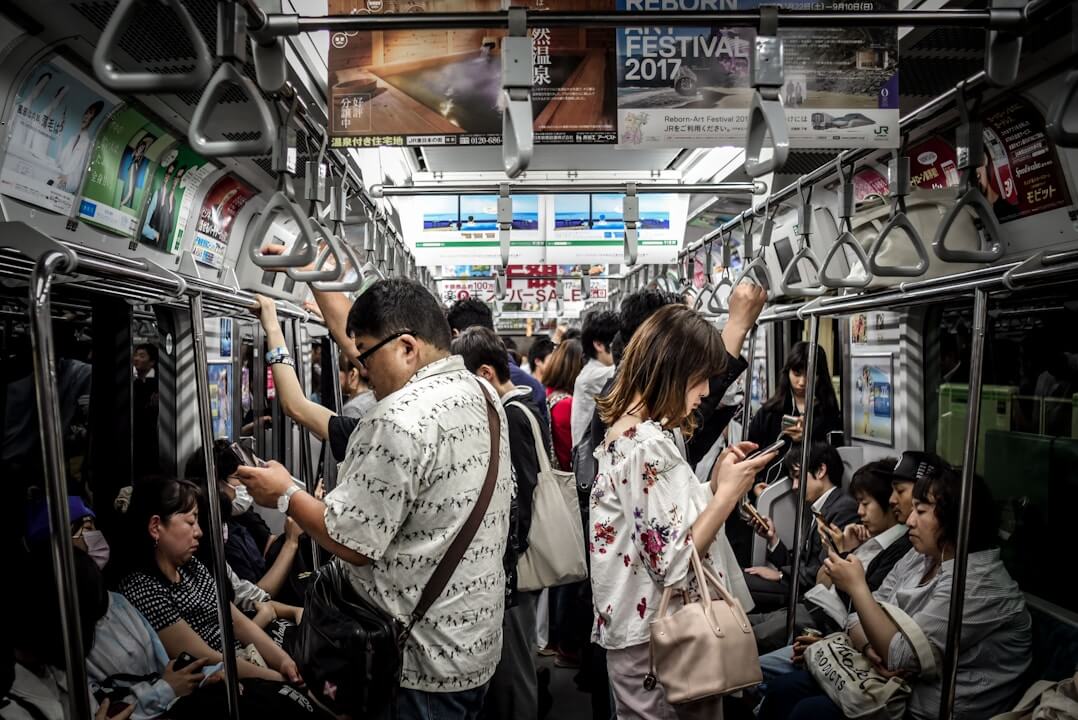
When traveling on local and commuter trains in Japan, you’ll quickly notice that eating is generally discouraged. This isn’t just an arbitrary rule but reflects deeper cultural values and practical considerations that shape public behavior in Japan.
Why Eating is Discouraged on Local Trains
Local trains in Japan, particularly in urban areas like Tokyo, Osaka, and Kyoto, are often crowded spaces where passengers stand in close proximity to one another. There are several practical reasons why eating is frowned upon:
- Limited space: Most local trains don’t have tray tables or adequate space for eating comfortably
- Short journey times: Local train rides typically last between 5-30 minutes, making meals unnecessary
- Crowded conditions: During rush hour, trains can be packed to 200% capacity, making eating physically difficult and potentially messy
- Consideration for others: The Japanese concept of meiwaku (迷惑) – causing trouble or inconvenience to others – extends to eating odorous foods in confined spaces
One Japanese commuter explained it to me this way: “We think about how our actions affect others. If I eat something smelly on a crowded train, everyone must smell it without choice.”
Cultural Norms Around Commuter Train Behavior
The reluctance to eat on commuter trains stems from Japan’s cultural emphasis on wa (和) – harmony and group cohesion. This manifests in several ways:
- Cleanliness: Japan places high value on cleanliness in public spaces
- Public decorum: Maintaining proper behavior in public is considered essential
- Minimal disruption: Activities that could disturb others are generally avoided
- Silent commuting: Most passengers remain quiet, often using their commute time for sleeping or reading
In Japanese society, the needs of the group typically take precedence over individual desires. Eating on a crowded train might satisfy your hunger but could inconvenience dozens of other passengers.
Acceptable Exceptions
While the general rule discourages eating, there are some commonly accepted exceptions:
| Acceptable | Not Acceptable |
|---|---|
| Drinking water or tea from a sealed bottle | Eating aromatic foods |
| Small, non-messy snacks for children | Messy foods that might spill |
| Candy or throat lozenges | Full meals |
| Medical necessities (e.g., for diabetics) | Alcoholic beverages (except on designated trains) |
If you must eat something on a local train due to medical reasons or to attend to a child’s needs, it’s best to be discreet and choose foods that won’t create strong odors or crumbs.
Rural vs. Urban Train Etiquette
Interestingly, the strictness of these unwritten rules varies depending on location:
Urban Train Etiquette:
- Stricter adherence to no-eating norms
- More crowded conditions make eating impractical
- Higher likelihood of disapproving looks if rules are broken
Rural Train Etiquette:
- Slightly more relaxed attitudes, especially on longer local routes
- Less crowding means eating might be more physically possible
- More tolerance for small snacks or drinks, though the basic principle of consideration remains
A traveler shared: “On a rural train in Hokkaido, I noticed locals occasionally having a small snack. The atmosphere was more relaxed than in Tokyo, but people were still mindful about choosing non-messy foods and cleaning up thoroughly.”
How to Navigate as a Visitor
If you’re visiting Japan and unsure about whether you can eat on a particular local train:
- Observe locals: Take cues from Japanese passengers
- Consider the setting: Is the train crowded? Is it a short journey?
- Choose wisely: If you must eat, opt for odorless, non-messy foods
- Clean thoroughly: Leave no trace if you do eat something
Remember that while breaking this social norm might not result in formal punishment, it could cause discomfort to those around you and potentially reinforce negative stereotypes about tourists.
Also Read: When Can You Drink In Japan? & Why Does Japan Have No Trash Cans?
The Complete Guide to Eating on Trains in Japan: Rules, Etiquette, and Tips
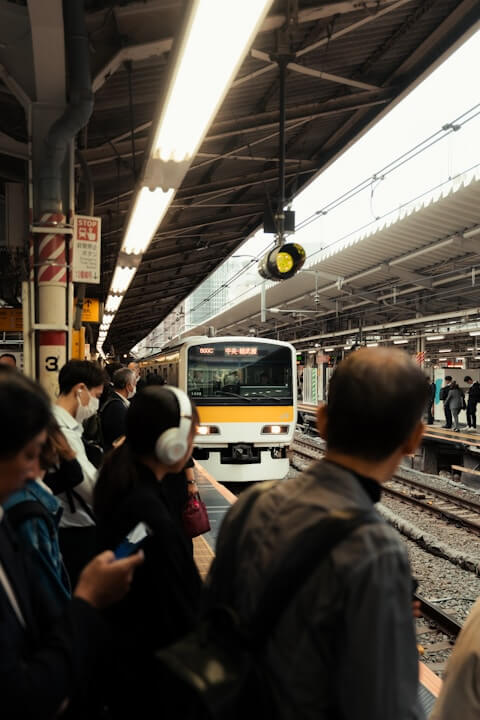
Japan’s efficient train system is renowned worldwide, but navigating the cultural expectations around eating on these trains can be confusing for international travelers.
Whether you’re planning to zip across the country on a bullet train or commute through Tokyo on a local line, understanding when and how you can eat on trains in Japan is essential for a respectful and enjoyable journey.
In Japan, the rules about eating on trains aren’t always explicitly stated but are deeply embedded in cultural norms that prioritize consideration for others.
This comprehensive guide will help you understand the nuances of train dining etiquette in Japan, introduce you to the delightful tradition of ekiben (train station bento boxes), and provide practical tips to ensure you travel like a respectful local.
Understanding the Basic Rules: Where You Can and Cannot Eat
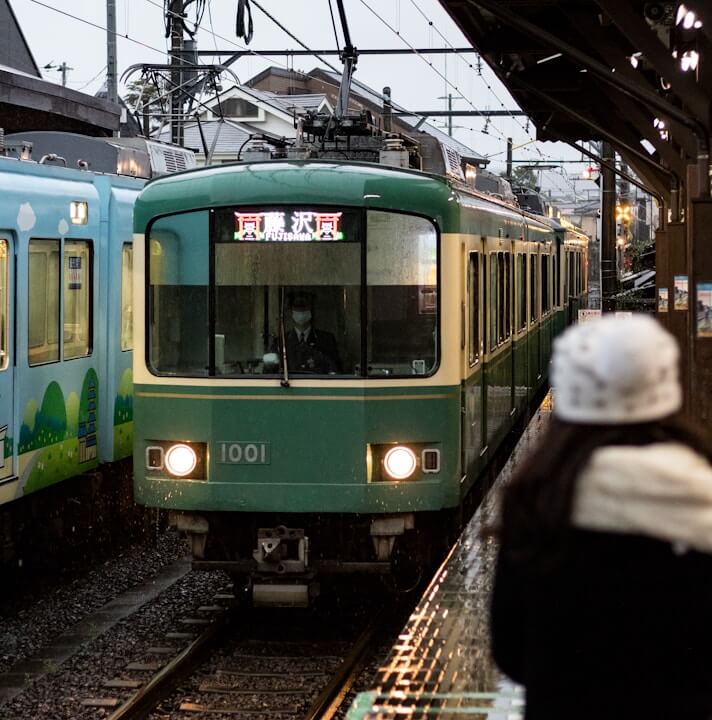
The first thing to understand about eating on trains in Japan is that the rules vary significantly depending on the type of train you’re riding:
Long-Distance Trains: Generally Acceptable
On long-distance trains such as the Shinkansen (bullet train), Limited Express trains, and overnight sleeper trains, eating and drinking are widely accepted and even encouraged. These trains typically feature:
- Tray tables that fold down from the seat in front of you
- Cup holders designed for beverages
- More spacious seating arrangements
- Longer journey times (typically over an hour)
The Green Cars (first-class carriages) on these trains offer even more comfortable dining experiences with wider seats and more personal space.
Local and Commuter Trains: Generally Discouraged
On city trains, subway lines, and commuter trains in metropolitan areas like Tokyo, Osaka, and Kyoto, eating is generally not considered appropriate. These trains are characterized by:
- Crowded conditions, especially during rush hours
- Lack of tray tables or designated eating spaces
- Short journey times between stations
- Limited space for passengers
While there are no official rules prohibiting eating on these trains, doing so may attract disapproving glances from locals who consider it inconsiderate.
The Tradition of Ekiben: A Highlight of Train Travel in Japan
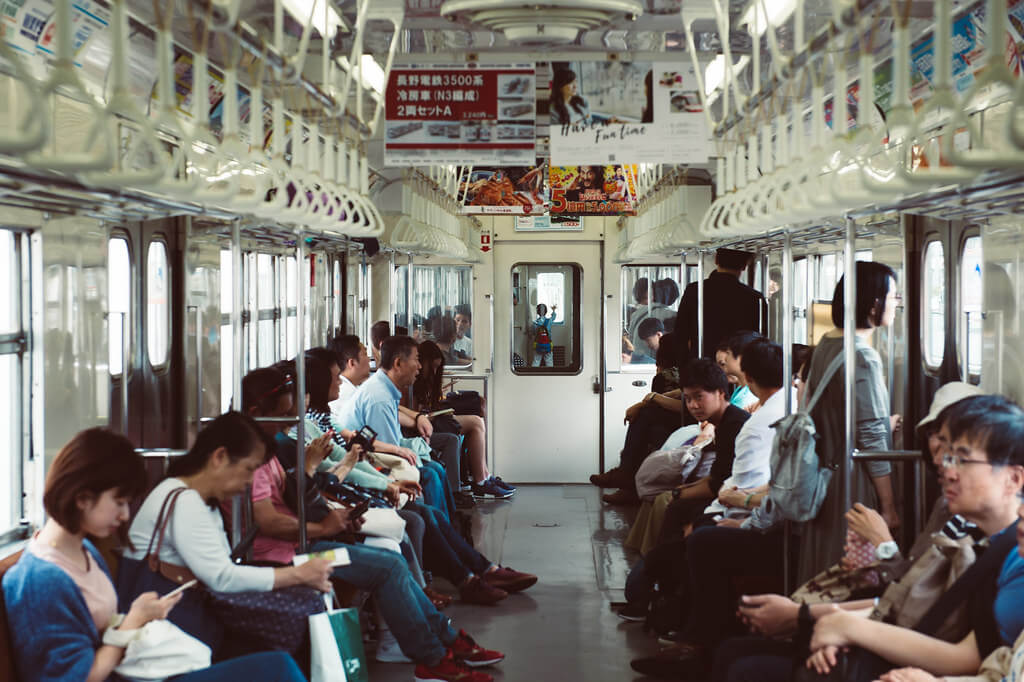
One of the most delightful aspects of long-distance train travel in Japan is the opportunity to enjoy an ekiben (駅弁) – a portmanteau of “eki” (station) and “bento” (boxed meal). These specially crafted boxed meals are:
- Sold at major train stations throughout Japan
- Featuring regional specialties and seasonal ingredients
- Beautifully packaged and presented
- Designed to be eaten comfortably on trains
Ekiben are more than just convenient meals; they’re a cultural institution that connects travelers to the culinary heritage of the regions they’re passing through. From Hokkaido’s seafood to Kyushu’s tonkatsu, each ekiben tells a story about local cuisine.
How to Identify If Eating Is Allowed on a Particular Train
Not sure if it’s appropriate to unwrap your sandwich on a particular train? Here are some reliable indicators that eating is acceptable:
Physical Indicators on the Train
- Presence of tray tables: If seats have fold-down tables, this is a clear sign that eating is expected
- Cup holders: Designated spaces for beverages indicate that drinking (and likely eating) is acceptable
- Spacious seating: More room between seats suggests a more relaxed environment where eating is permitted
- Food trolleys or vendors: If food is sold onboard, it’s definitely acceptable to eat
Train Type and Journey Duration
- Shinkansen and Limited Express trains: Always appropriate for dining
- Reserved seating sections: Generally suitable for eating, even on some commuter lines
- Journeys longer than 1 hour: More acceptable to eat than on short trips
- Tourist-oriented scenic trains: Often encourage enjoying local foods while taking in the views
Observing Other Passengers
One of the most reliable methods is simply to observe what locals are doing:
- If Japanese passengers are eating, it’s safe for you to do so as well
- If nobody else is eating despite a long journey, it might be best to wait
- During busy commuting hours, eating is rarely seen regardless of train type
Etiquette for Opening and Disposing of Food Packaging
Once you’ve determined that eating is appropriate on your train, follow these guidelines for handling your food with consideration:
Opening Food Packages
- Minimize noise: Open packaging carefully and quietly to avoid disturbing others
- Be mindful of space: Keep your elbows tucked in when unwrapping food
- Contain aromas: Try to open strongly scented foods quickly and efficiently
- Prepare in advance: Consider removing outer packaging before boarding if possible
Managing Your Meal Space
- Keep food contained: Use the tray table to keep everything organized
- Avoid spreading out: Keep your meal compact within your personal space
- Be careful with liquids: Secure drinks in cup holders to prevent spills
- Have napkins ready: Bring tissues or wet wipes for cleaning hands and surfaces
Proper Disposal Techniques
- Never leave trash behind: This is considered extremely disrespectful in Japan
- Compact your garbage: Fold empty containers and packaging to minimize space
- Carry a small plastic bag: Many Japanese travelers bring a designated bag for trash
- Take everything with you: Most trains don’t have garbage bins, so be prepared to carry your trash until you exit
Remember that Japanese trains are kept impeccably clean, and passengers are expected to leave no trace of their meals.
Handling Trash and Leftovers
The proper disposal of garbage is perhaps the most important aspect of eating etiquette on Japanese trains:
The “Carry In, Carry Out” Principle
Most trains in Japan, even long-distance ones, have limited or no trash receptacles. This reflects the Japanese principle of personal responsibility for your waste:
- Be prepared to take all your trash with you when you exit the train
- Some major stations have sorting bins on platforms, but many smaller stations don’t
- Convenience stores (konbini) near stations often have trash bins for customers
Sorting Your Waste
If you do find disposal bins at stations, you’ll need to sort your waste according to Japanese recycling standards:
- Plastic bottles: Empty, rinse if possible, remove labels, and crush
- Cans and glass: Empty and place in designated receptacles
- Food waste: Goes in burnable trash (燃えるゴミ)
- Packaging: Different types of plastic and paper may need separate sorting
Dealing with Leftovers
Finishing your meal is considered respectful in Japanese culture:
- Try to order or purchase only what you can finish
- If you have leftovers, seal them properly before storing them in your bag
- Avoid leaving food visible or exposed when you’re done eating
Foods to Avoid on Japanese Trains
Not all foods are created equal when it comes to train travel in Japan. Here’s what to avoid:
Strong-Smelling Foods
Foods with potent aromas can quickly fill a train car and disturb other passengers:
- Natto (fermented soybeans)
- Durian or other pungent fruits
- Strong-smelling cheeses
- Heavily spiced dishes
- Some types of fish
Noisy Foods
In a culture that values quiet public spaces, these foods can be disruptive:
- Crunchy chips or crackers
- Hard candies that require unwrapping
- Foods in noisy packaging
- Apples or other crisp fruits that make loud bites
Messy Foods
Avoid anything that could potentially:
- Spill or drip (soups, noodles with broth)
- Crumble easily (flaky pastries)
- Require special utensils or complex eating techniques
- Stain seats or floors if accidentally dropped
- Leave residue on your hands that might transfer to train surfaces
Alcoholic Beverages
While drinking alcohol is generally acceptable on long-distance trains:
- Exercise moderation and remain quiet
- Be aware that becoming visibly intoxicated is frowned upon
- Avoid drinking during morning commute hours
- Consider the cultural context – business travelers may have a beer on evening trains, but this doesn’t mean rowdy drinking is acceptable
Best Practices for Being a Considerate Traveler
Follow these guidelines to ensure you’re respecting Japanese train etiquette while enjoying your meal:
Timing Your Meal
- Avoid rush hours for eating, even on trains where it’s generally acceptable
- Wait until the train is moving steadily to prevent spills during stops and starts
- Consider eating at less busy times when fewer passengers are around
Minimizing Impact on Others
- Keep voices low when eating with companions
- Avoid strong perfumes or colognes that might mix with food smells
- Be mindful of allergies – in close quarters, your food could affect others
- Clean your seating area thoroughly after eating
Preparing Appropriately
- Bring hand sanitizer or wet wipes for before and after eating
- Pack easily manageable foods that don’t require complex preparation
- Consider bento boxes with compartments that keep foods separate and contained
- Use appropriate utensils – chopsticks for Japanese foods, forks only when necessary
Cultural Awareness
- Observe and follow local behavior – if in doubt, watch what Japanese passengers do
- Acknowledge mistakes graciously if someone indicates you’re breaking an unwritten rule
- Remember that consideration for others is the underlying principle of all Japanese etiquette
By following these guidelines, you’ll not only show respect for Japanese customs but also enhance your own experience of train travel in this fascinating country.
The joy of savoring an ekiben while watching the Japanese countryside roll by is one of travel’s great pleasures – one that’s best enjoyed with cultural awareness and consideration.
Special Considerations for Eating on Japanese Trains
When navigating the rules of eating on trains in Japan, certain circumstances and individuals may warrant exceptions. Understanding these nuances can help all travelers feel comfortable while still respecting Japanese cultural norms.
Rules for Children, Elderly, and Those with Medical Conditions
Children are generally given more leniency when it comes to eating on trains in Japan. Japanese people understand that young children may need snacks to stay content during travel, even on commuter trains where eating is typically discouraged. However, parents should:
- Bring mess-free snacks that won’t create crumbs or odors
- Clean up thoroughly after children eat
- Keep food contained to immediate seating area
- Bring small, quiet snacks rather than full meals on local trains
For elderly passengers and those with medical conditions such as diabetes, hypoglycemia, or those taking medications with food, exceptions are typically understood. If you need to eat for health reasons:
- Be discreet and consume only what’s necessary
- Choose non-aromatic foods when possible
- Consider informing nearby passengers with a simple explanation if appropriate
- Carry a medical card in Japanese explaining your condition for peace of mind
Drinking Beverages vs. Eating Food
The rules for drinking beverages are more relaxed than those for eating solid food across all train types in Japan:
| Train Type | Drinking Rules | Food Rules |
|---|---|---|
| Shinkansen/Limited Express | Drinking freely allowed | Eating allowed and common |
| Commuter/Local Trains | Water and non-alcoholic drinks generally acceptable | Eating discouraged |
| Metro/Subway | Water acceptable, other drinks best avoided | Eating strongly discouraged |
When drinking on any train:
- Use containers with secure lids to prevent spills
- Be mindful of sudden train movements that could cause accidents
- Alcoholic beverages are acceptable on long-distance trains but should be consumed responsibly
- Coffee and tea are fine on long-distance trains but use caution with hot drinks
Seasonal Considerations and Holiday Travel
Japanese train etiquette around food can shift slightly with the seasons and during holidays:
Cherry Blossom (Sakura) Season and Autumn Foliage Season:
- Trains to popular viewing spots become extremely crowded
- Even on long-distance trains, eating may be more difficult due to increased passengers
- Special seasonal ekiben are available but seating space may be limited
New Year (Oshogatsu):
- Trains become exceptionally busy with people traveling to hometowns
- Despite crowding on normally “eating-friendly” trains, many travelers will still enjoy ekiben
- Special New Year ekiben featuring traditional foods are popular
Golden Week and Obon Festival:
- Similar to New Year, trains are very crowded
- Eating etiquette becomes even more important due to limited space
- Reservations highly recommended if you want to enjoy meals comfortably
“During peak travel seasons, I always purchase my ekiben early and secure a reserved seat. This ensures I can enjoy my meal without worrying about space or disturbing others.” – Seasoned Japan traveler
Train-Specific Dining Cars and Services
While most Japanese trains don’t have dedicated dining cars as seen in some European countries, certain premium services do offer enhanced dining experiences:
Joyful Trains (Kanko Ressha):
- Specialty tourist trains often feature unique dining experiences
- Trains like the “Resort Shirakami” and “SL Ginga” offer special meal services
- These experiences typically require advance booking
Cruise Trains:
- Luxury trains such as the “Seven Stars in Kyushu” and “Train Suite Shiki-shima”
- Feature full-service dining cars with gourmet meals
- Represent the pinnacle of Japanese train dining experiences
- Extremely expensive and require bookings months in advance
Trolley Services:
- Some Shinkansen lines feature trolley services selling drinks, snacks, and light meals
- Attendants move through the carriages at regular intervals
- Convenient for purchasing additional refreshments during your journey
Green Car (first class) services:
- Often include complimentary drinks and sometimes light snacks
- More spacious seating makes dining more comfortable
- Some limited express trains offer meal delivery to your seat if ordered in advance
For travelers seeking a special train dining experience, researching these options in advance can add a memorable dimension to your Japan rail journey beyond the standard ekiben experience.
The Ekiben Experience: A Culinary Journey on Japanese Trains
Eating on trains in Japan isn’t just about satisfying hunger—it’s about embracing a cherished cultural tradition that combines the joy of travel with regional culinary delights.
The ekiben (駅弁), a portmanteau of “eki” (station) and “bento” (boxed meal), represents one of Japan’s most unique gastronomic experiences.
First-hand Accounts from Travelers
“The moment I opened my Tohoku-themed ekiben on the Shinkansen to Sendai, I felt like I was already experiencing the region through its flavors,” shares Emma, an American who has visited Japan multiple times. “The presentation was so beautiful I almost didn’t want to eat it!“
Many travelers echo this sentiment. The ritual of enjoying an ekiben while watching the Japanese countryside roll by has become a highlight for visitors. Michael, a British food blogger, describes it as “a moving feast that connects you to Japan’s regional identity” after sampling over 30 different ekiben during his rail journeys across the country.
The experience typically unfolds like this: you arrive at a major station, browse the colorful ekiben shops with their plastic food displays, select a box representing local specialties, and then savor it once aboard your long-distance train. The careful timing, the unveiling of multiple compartments, and the discovery of seasonal ingredients all contribute to making this more than just a meal.
Popular Routes for Enjoying Ekiben
Certain train routes have become legendary among ekiben enthusiasts:
| Route | Duration | Notable Ekiben |
|---|---|---|
| Tokyo to Kyoto (Tokaido Shinkansen) | 2h 15m | Makunouchi bento, Kyoto’s yudofu bento |
| Tokyo to Sendai (Tohoku Shinkansen) | 1h 30m | Gyutan (beef tongue) bento, Sendai zunda mochi |
| Osaka to Hiroshima (Sanyo Shinkansen) | 1h 25m | Hiroshima-style okonomiyaki bento, Kobe beef bento |
| Tokyo to Kanazawa (Hokuriku Shinkansen) | 2h 30m | Kanazawa crab bento, Toyama black ramen bento |
| Sapporo to Hakodate (Limited Express) | 3h 30m | Hokkaido seafood bento, Hakodate squid rice |
The Tokyo to Kyoto route on the Tokaido Shinkansen remains the most popular for first-time ekiben experiences, offering enough time to enjoy the meal while passing iconic sights like Mount Fuji on clear days.
For the ultimate ekiben adventure, the Joyful Train services like the Tohoku Emotion and Izu Craile offer specially designed gourmet experiences where the journey itself revolves around regional cuisine.
Recommended Ekiben for First-Timers
If you’re new to ekiben, these classics offer accessible flavors while providing an authentic experience:
- Makunouchi Bento (幕の内弁当) – The traditional “balanced meal” bento featuring rice, grilled fish, Japanese omelet, and seasonal vegetables
- Kani Meshi (かに飯) – Crab meat on rice, especially popular in stations along the Sea of Japan
- Shinkansen Bento – A novelty option shaped like the bullet train, popular with both children and adults
- Chicken Kara-age Bento – Japanese fried chicken with rice, a crowd-pleaser for those hesitant about more exotic options
- Ekiben Assortment – Some stations offer sampler boxes with smaller portions of regional specialties
Pro tip: Tokyo Station’s “Ekibenya Matsuri” shop offers ekiben from all over Japan, making it possible to try regional specialties without traveling to those areas.
Common Mistakes Foreigners Make and How to Avoid Them
Even experienced travelers can stumble when navigating the ekiben experience. Here are common pitfalls and how to avoid them:
Mistake #1: Waiting until you’re on the train to buy your ekiben
Many first-timers don’t realize that the best selection is at the station, not on board. Some trains have no food service at all. Always purchase your ekiben before boarding, ideally 15-20 minutes before departure to ensure freshness.
Mistake #2: Not checking if heating is required
Some ekiben come with a special heating mechanism (often involving pulling a string that activates a chemical reaction). If you don’t activate it, you might end up with a cold meal that was meant to be enjoyed warm.
Mistake #3: Opening everything at once
Ekiben are designed to be eaten in stages, with multiple compartments and layers. Opening everything immediately can lead to a messy tray table and cold food. Unveil each section as you’re ready to eat it.
Mistake #4: Forgetting chopsticks or not knowing how to use them
While most ekiben include disposable chopsticks, some budget options might not. Always check, and consider practicing your chopstick skills before your trip.
Mistake #5: Discarding packaging improperly
Train staff don’t collect trash continuously on most routes. Keep your packaging neatly stacked until you reach a station with disposal facilities or until the attendant comes through with a trash bag (typically on Shinkansen).
By avoiding these common mistakes, you’ll not only enjoy your ekiben more fully but also blend in with experienced Japanese travelers who have perfected this delightful ritual of rail dining.

